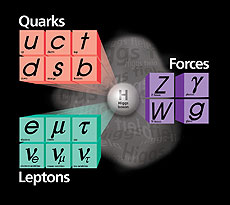The Standard Model: The most successful theory ever
 |
| The Standard Model is a triumph of modern physics. With this handful of particles shown here, we can explain all of the matter we have encountered, from atoms to entire galaxies. |
Editor's note: "Physics in a Nutshell" is a new feature of Fermilab Today. In this column, Fermilab's Don Lincoln will define one commonly used term in physics. If you want a particular phrase defined or have a question, please email Fermilab Today.
The Standard Model. It's really a peculiar phrase. What's a model and what makes it standard?
In a physics context, the word "model" is analogous to the word "theory" as used by most people. We need to distinguish what actually happens when subatomic particles interact from our understanding of them. Hopefully, they're the same, but this is never guaranteed. The history of science is full of explanatory ideas that eventually were overthrown.
So what scientists do is construct what we call models, which are conceptual and mathematical ideas that explain our data. Once we have a model, we can use the tools of logic and math to make predictions. We then make additional measurements, and if they agree with the predictions of the model, we feel justified in continuing to believe the model is an accurate description of reality.
The model that we use to describe our subatomic reality is called "standard" because it is essentially universally accepted. After tens of thousands of measurements, the model continues to agree with the outcome of our research.
The standard model contains 12 particles that are the smallest building blocks we've ever found. These particles are broken into two classes: quarks and leptons. There are six quarks, oddly named up, down, charm, strange, top and bottom. Up and down quarks are found at the center of atoms, housed inside the familiar protons and neutrons, while the other four quarks are only found inside the collisions of particle accelerators.
Out of the leptons, the most familiar is the electron that makes up the outer layer of atoms. There are two other charged leptons, called a muon and a tau, which also are found only in particle accelerators and in cosmic rays from space. There are also some electrically neutral leptons called neutrinos. Neutrinos originate in nuclear reactions and we live in a bath of them from the sun. Since neutrinos only experience the weak nuclear force, they rarely interact. In fact, it takes about five light years of solid lead to have a fifty percent chance of stopping a neutrino from the Sun.
In addition to the particles, the Standard Model includes three forces that govern the behavior of matter. These forces are electromagnetism and the strong and weak nuclear forces. The familiar force of gravity is currently not included in the standard model. We understand the subatomic forces in terms of two matter particles exchanging force particles, like two kids tossing a baseball back and forth. The force particles are the photon (electromagnetism), the gluon (strong nuclear force) and the W & Z bosons (the weak force).
With these 12 matter particles and 4 force-carrying particles, we can explain the outcomes of all of our experimental data. We even understand, in principle, how to take these building blocks and reconstruct an entire universe.
The Standard Model is known to be incomplete and it doesn't answer all questions. However, it is a marvelous intellectual achievement and we expect that measurements taken at particle physics laboratories spread across the globe will continue to improve our understanding of the universe. These new insights will be incorporated into a new and improved Standard Model.
—Don Lincoln
|